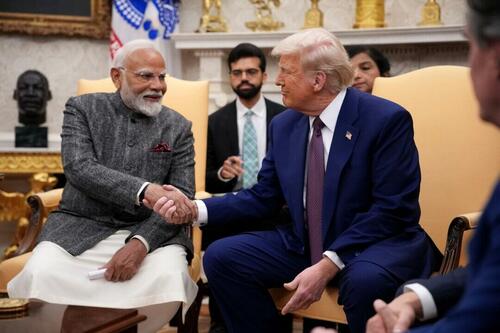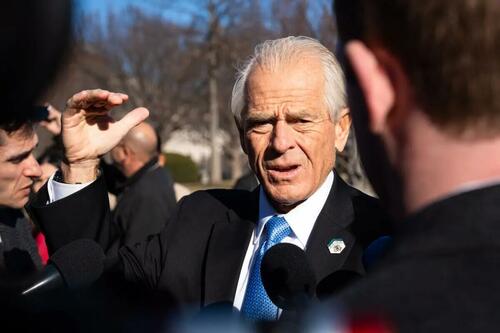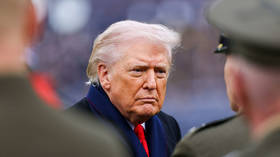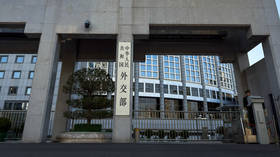
Trump’s 50 Percent Tariff On India Takes Effect
Authored Andrew Moran via The Epoch Times,
President Donald Trump’s additional 25 percent tariff on India became effective at midnight on Aug. 27, bringing the total rate to 50 percent on many imports entering the United States.

The president, in his global tariffs announcement in April, introduced a 26 percent levy on Indian goods, aimed at pressuring the Indian government to lower its trade barriers. Months later, the rate was revised slightly lower to 25 percent.
In an Aug. 6 executive order, Trump implemented an additional 25 percent tariff on India, saying its government is “currently directly or indirectly importing Russian Federation oil.”
Since Russia invaded Ukraine in 2022, India has been one of Russia’s most significant trading partners, with annual bilateral trade reaching almost $69 billion.
Energy has been the primary product uniting the two countries for the past few years.
With crude oil imports exceeding $52 billion last year, India accounts for an estimated one-third of Russia’s petroleum exports, fueled by a sanction-driven discount.
In December 2024, the Group of Seven (G7) introduced a price cap of $60 per barrel on Russian Urals crude to reduce the country’s oil revenues. Because global oil prices have declined—a barrel of U.S. West Texas Intermediate crude oil is trading at roughly $64 per barrel—the discount has become minimal.
“India swapped high-shipping-cost crude from the US, South America, and Africa with cheaper Russian crude,” energy economist Anas Alhajji said in a note for Energy Outlook Advisors. “About 932 kb/d [1,000 barrels per day] of costlier oil or oil redirected to Kuwait and Oman’s refineries was replaced by Russian imports. Sanctions on Russian crude shaped trade directions and India’s purchasing patterns.”
U.S. officials say that India’s continued transactions are funding Russia’s war effort in Ukraine.
In an Aug. 4 Truth Social post, Trump said India has been exploiting discounted Russian crude to sell it “on the open market for big profits.”
“They don’t care how many people in Ukraine are being killed by the Russian War Machine,” he said.
India’s government has dismissed these criticisms, stating in a response to The Epoch Times that these purchases are aimed at providing its nearly 1.5 billion population with affordable energy.
“In this background, the targeting of India is unjustified and unreasonable,” a spokesperson for the Indian Foreign Ministry said.
White House top trade adviser Peter Navarro echoed the president’s sentiment, telling reporters this past week that India has been “profiteering” on the war in Ukraine.
“India doesn’t appear to want to recognize its role in the bloodshed,” Navarro said on Aug. 21.
He also said India’s current trade policies are detrimental to the United States.

Peter Navarro, White House senior counselor for trade and manufacturing, speaks to reporters at the White House on Feb. 4, 2025. Madalina Vasiliu/The Epoch Times
“We run a massive trade deficit with them. So that hurts American workers, hurts American businesses,” Navarro said.
“Then they use the money that they get from us when they sell us stuff to buy Russian oil, which is then processed by refiners, and they make a bunch of money there. But then the Russians use the money to build more arms and kill Ukrainians, and so American taxpayers have to provide more aid, military-style, to the Ukrainians.”
According to the U.S. Trade Representative’s Office, the U.S. goods trade deficit with India was nearly $46 billion in 2024, representing a 5.9 percent increase from the previous year.
Trade Moving Forward
New tariffs are expected to disrupt the more than $200 billion in annual U.S.–India trade. A modest drop in imports of Indian goods was observed in the latest data.
In June, according to the Bureau of Economic Analysis, imports tumbled 3 percent from the previous month but were up 29 percent year-over-year.
New data from Descartes Systems Group indicate a significant rise in U.S. container imports, with volumes increasing by more than 18 percent in July compared to June. Notably, the group’s August Global Shipping Report highlights a nearly 14 percent surge in shipments from India—underscoring companies’ preparations for the White House’s tariffs.
“Trade uncertainty remains high, however, as U.S. importers evaluate their supply chains in the face of the August 1 implementation of reciprocal duties on over 60 countries, the August 7 start of India-specific tariffs and the universal copper tariff, and the October 15 expiration of the U.S.–China tariff truce,” Jackson Wood, director of industry strategy at Descartes, said in a statement.
The state of trade negotiations remains unclear after a planned visit by a U.S. trade delegation to New Delhi this week was canceled.
At a recent Economic Times forum in New Delhi, Indian Foreign Minister Subrahmanyam Jaishankar said that discussions are continuing, but there are policies that his government wishes to defend, particularly for farmers and small businesses.
“We have some redlines in the negotiations, to be maintained and defended,” he said. “It is our right to make decisions in our ‘national interest.’”
ING economists warn that India’s growth prospects are uncertain amid potential trade strife.
The consensus forecast suggests that India’s economy expanded by 6.6 percent in the second quarter, down from the 7.4 percent growth rate in the first three months of 2025.
“High-frequency indicators point to a moderation in both private consumption and investment. Additionally, higher-than-expected tariffs and rising uncertainty around India’s trade policy with the US are emerging as downside risks to the 2025 growth outlook,” the ING economists said in a note.
Policymakers are using the current trade situation with the United States as a measure to employ domestic reforms, such as changes to the goods and services tax. The government might also be hedging its geopolitical bets as leaders attempt to enhance relations with China.
Indian Prime Minister Narendra Modi is scheduled to meet with Chinese leader Xi Jinping later this week on the sidelines of the Shanghai Cooperation Organisation. This will be Modi’s first visit to China in seven years.
According to Joe Maher, assistant economist at Capital Economics, a 50 percent tariff “would be large enough to have a material impact on [gross domestic product] growth” for India.
“If it sticks, the resulting drop in exports to the US could reduce GDP growth by 0.8%-pts both this year and next,” Maher said in a note.
Tyler Durden
Wed, 08/27/2025 – 08:25


















